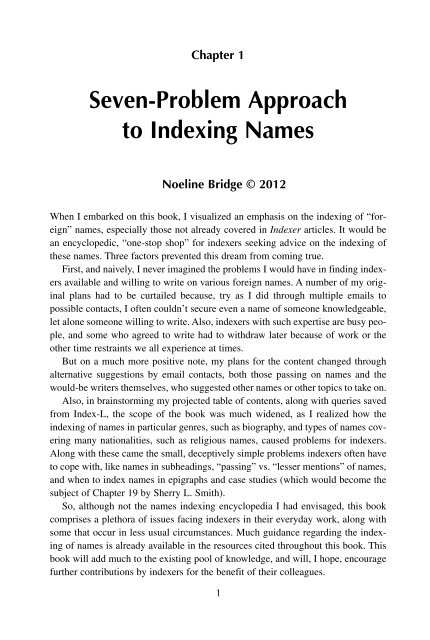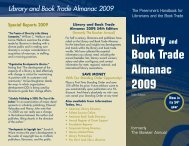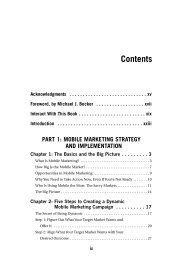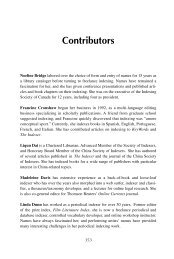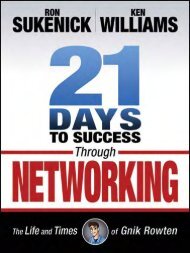Sample Chapter - Books
Sample Chapter - Books
Sample Chapter - Books
- No tags were found...
You also want an ePaper? Increase the reach of your titles
YUMPU automatically turns print PDFs into web optimized ePapers that Google loves.
<strong>Chapter</strong> 1Seven-Problem Approachto Indexing NamesNoeline Bridge © 2012When I embarked on this book, I visualized an emphasis on the indexing of “foreign”names, especially those not already covered in Indexer articles. It would bean encyclopedic, “one-stop shop” for indexers seeking advice on the indexing ofthese names. Three factors prevented this dream from coming true.First, and naively, I never imagined the problems I would have in finding indexersavailable and willing to write on various foreign names. A number of my originalplans had to be curtailed because, try as I did through multiple emails topossible contacts, I often couldn’t secure even a name of someone knowledgeable,let alone someone willing to write. Also, indexers with such expertise are busy people,and some who agreed to write had to withdraw later because of work or theother time restraints we all experience at times.But on a much more positive note, my plans for the content changed throughalternative suggestions by email contacts, both those passing on names and thewould-be writers themselves, who suggested other names or other topics to take on.Also, in brainstorming my projected table of contents, along with queries savedfrom Index-L, the scope of the book was much widened, as I realized how theindexing of names in particular genres, such as biography, and types of names coveringmany nationalities, such as religious names, caused problems for indexers.Along with these came the small, deceptively simple problems indexers often haveto cope with, like names in subheadings, “passing” vs. “lesser mentions” of names,and when to index names in epigraphs and case studies (which would become thesubject of <strong>Chapter</strong> 19 by Sherry L. Smith).So, although not the names indexing encyclopedia I had envisaged, this bookcomprises a plethora of issues facing indexers in their everyday work, along withsome that occur in less usual circumstances. Much guidance regarding the indexingof names is already available in the resources cited throughout this book. Thisbook will add much to the existing pool of knowledge, and will, I hope, encouragefurther contributions by indexers for the benefit of their colleagues.1
2 Indexing NamesWhen I began to make presentations on names indexing and was sorting out mymethod of attack, it occurred to me that all my accumulated examples of names fellinto six categories. There was some overlap, but generally the process worked. Andwithin a couple of years, through reading messages on Index-L, I had added a seventhcategory. The categories are:1. Choice of initial element2. Length or brevity of a name: How much to include/exclude3. One-word names: When and how to add detail4. Distinguishing between people with similar names5. Variant names borne by one person, including changes of name6. Transliteration and Romanization of names7. Names as phrasesIn many ways, these issues underlie all the contributions in this book, so I havetaken this approach for this opening chapter, citing the individual chapters relevantin each category.CHOICE OF INITIAL ELEMENTThis is the category that concerns indexers most, over which they anguish the most.Given a name consisting of a collection of elements, which do you enter first? Intheory, the first mention of a person’s name in the text should be the full one; afterthat, an abbreviated form, usually the most commonly used last one, is cited. Alas,the indexer’s life isn’t that easy: The person may not be mentioned again, or thefirst element may differ between the text mention and the citation in the references,or worse, differ within the text itself. So indexers often have to consult indexingmanuals and reference works, along with articles in the indexing societies’ journals.When in doubt, indexers can confer with the author or editor; however, in their professionalcapacity, they should marshal evidence from the text and from referencesbefore asking.The following categories of problems are familiar to experienced indexers andquickly become so to those starting in the field.Names With PrefixesNames with prefixes occur in many countries and nationalities, in the Westernworld as well as other parts. It’s too large a category for me to go into detail here—
Seven-Problem Approach to Indexing Names 3it would take a book in itself. Advice is plentiful via the many names indexingresources and throughout this book.In order to decide whether to index under a prefix or a following element, onehas to know which element is a prefix. This presents a challenge, especially withnames containing several words of titles and family and clan information, as withthe Arab and Indonesian names explored in this book by Heather Hedden andMadeleine Davis, in <strong>Chapter</strong> 3 and <strong>Chapter</strong> 11, respectively, who explain the meaningsof commonly occurring elements of names in these societies.Some relevant questions to be answered before conducting a search are:• What nationality is the person? Differing guidelines exist forvarious countries. Also, in indexing, a lot depends on where asubject lived the most or at least dwelled for that part of his lifewritten about in the book. For example, persons with surnamesincluding prefixes living in their native countries are indexedaccording to the conventions of those countries, which oftenmeans entry under that part of the name following the prefix. Butif they lived primarily in English-speaking countries, they areindexed under the prefix.• What time period is involved? The ordering of the elements ofnames has often changed over time, with direct order evolving toinverted order.The following three questions are related:• What is the audience for the book? The age level of the readershipcan come into play here. I am in favor of using the conventionalorder for all names, the one to be found in library catalogs andreference books; children should be getting used to consultingthese titles.• What is the genre of the book? Academic works often call for astrictly conventional form of entry, unlike trade books ortextbooks.• Are there pertinent publisher guidelines and author preferences?In my experience, most publishers do not provide such detail intheir own guidelines. They may, however, point to style guides,such as the Chicago Manual of Style or Hart’s Rules, even citing aparticular edition. Author’s preferences may be gauged by usage inthe book; I’ve had academic authors contact me to make sure Iwill index the names of persons in their books by certainguidelines, usually the most formal and fullest forms.
4 Indexing NamesA typical example, where any of these factors may come into play, is the oftcitedexample of Vincent van Gogh. Is the indexer to use the Dutch form, beginningwith “Gogh” or bow to popular usage in many other countries by using “VanGogh”? Enid Zafran (in <strong>Chapter</strong> 17) and Jacqueline Pitchford (in <strong>Chapter</strong> 4)address the indexing of Vincent van Gogh from their two perspectives, Zafran as aU.S. indexer and Pitchford as a European one.Names with prefixes occur in several chapters of this book. In <strong>Chapter</strong> 6,Pitchford writes about German names. In <strong>Chapter</strong> 7, Francine Cronshaw explainsSpanish and Portuguese prefixes, and distinguishes between the two. In <strong>Chapter</strong> 5,I deal with French names.Compound Last Names/SurnamesIn theory, the easiest category is compound last names. The conventions prescribeentry under the first element of the last name. It’s easy for hyphenated names, ofcourse, but when they’re not linked, it’s a head-scratcher to know which is that crucialfirst element, as with Martin White’s examples in <strong>Chapter</strong> 14 of David LloydGeorge and Alexander McCall Smith. Some of my own bugbears are Arthur ConanDoyle, Sacha Baron Cohen, Ralph Vaughan Williams, John Foster Dulles, andWilliam Lyon Mackenzie King, especially the latter two, who often occur in myindexing of history and political science. Both have a single surname, hence they’reindexed as:Dulles, John FosterKing, William Lyon Mackenziein spite of often being referred to in texts and elsewhere as Foster Dulles andMackenzie King.Women often choose to be known under two last names, usually a birth and amarried name; however, and this is common to men as well, a seeming surnamemay be a given name. The indexer may need to sort out where the last name thatis to form the entry element begins. Subsequent mentions of the person could providethe answer, but, if there are none, the indexer must look further. The namesof well-known women, like Elizabeth Cady Stanton, will appear in biographicaldictionaries and library catalogs. A cited author may occur under a preferred lastname in the references, or a web search may be necessary (often a name can befound quickly on the website of the academic institution where she works on thefaculty, for example). See references should be made from the unused element ifthere is room in the index and if they don’t clutter the index unduly. In a book witha feminist perspective or on women’s studies/history, you could create manycross-references, and such enhancements would be essential in genealogical andlocal history indexing.
6 Indexing Namespatronymics from words indicating titles, tribes, and so on can be very difficult.The International Federation of Library Associations and Institutions’ (IFLA’s)Names of Persons resource provides guidance for many countries. In <strong>Chapter</strong> 3 ofthis book, Arabic usage is explained by Hedden, and Indonesian usage is explainedby Davis in <strong>Chapter</strong> 11. Hedden also deals with the “reverse” of a patronymic, thename of a son in names beginning Abu.East Asian NamesEast Asian names often crop up in indexing. It’s often a matter of sorting out thesurname from the given names, and there is ample guidance in reference sources,often by way of recognizable patterns, like societies where a surname typically consistsof one syllable and a given name of two. Even so, some names elude the patterns.A valuable source for Chinese surnames is Liqun Dai’s Indexer article onChinese names, with its listing of the 100 most common surnames.The custom of referring to the person by surname followed by given namefavors indexing. One simply indexes the name like that. The same convention isused by reputable newspapers and periodicals, whose press style guides usually followthe same conventions as those for us indexers. Newspaper junkies, like myself,will have often encountered well-known names, the ones most likely to crop inindexing of current events, in newspaper articles.Examples where much ink (virtual and actual) has been spilled are the well-knownVietnamese names, Ngo Dinh Diem and Vo Nguyen Giap, indexed in this form in theLibrary of Congress (LOC) Authorities and by Nancy Mulvany in Indexing <strong>Books</strong>and Hans Wellisch in Indexing from A to Z. However, these persons are usuallyreferred to as Premier Diem and General Giap, following the Vietnamese conventionof using first names (see also Janet Russell’s exposition in <strong>Chapter</strong> 24 around anexample from LOC Authorities). So some sources, like the Chicago Manual of Styleand IFLA’s Names of Persons, prefer entry under the well-known first name:Diem, Ngo DinhGiap, Vo NguyenThe indexing of names like these may well be determined by the publisher’sstyle guide or author’s preferences.Many complications of other East Asian names are discussed in Davis’s chapterson Hmong and Indonesian names (<strong>Chapter</strong> 10 and <strong>Chapter</strong> 11, respectively)and in Sue Lightfoot’s chapter on Thai names (<strong>Chapter</strong> 13).Arabic NamesArabic names are another group of names in which it can be very difficult to sortout which element should go first or whether to use direct or inverted order. It is the
Seven-Problem Approach to Indexing Names 7subject of <strong>Chapter</strong> 3 by Heather Hedden and is also dealt with extensively in<strong>Chapter</strong> 14 by Martin White. Outside this book, HURIDOCS supplies usages formodern names in different countries, as does IFLA’s Names of Persons. In herchapter, Hedden also discusses the indexing of modern names well known in theWest, where some element of the name has become the one most commonlyreferred to, as with Saddam Hussein (Hussein), Osama bin Laden (bin Laden), andGamal Abdel Nasser (Nasser), advising entry in Western style, beginning with thatknown element.LENGTH OR BREVITY OF A NAME:HOW MUCH TO INCLUDE/EXCLUDEIndexers are often presented with longer and shorter versions of the same person’sname in different texts/projects and within the same book. In back-of-the-bookindexing, and in general, there often isn’t any need to go beyond what is presentedwithin a particular text. Indexing in more “open” contexts, like ongoing periodicalindexing or in large databases, may call for a longer form to be established as theauthoritative version, to distinguish among people with similar names.Biographical dictionaries and encyclopedias will present names in their fullestforms because their users have to make sure of the identities of requested names.Although library cataloging rules have changed over the decades to focus on theform of name “by which [a person] is commonly known” (such as in the Anglo-American Cataloguing Rules, 2nd edition, or AACR2, for example), the Library ofCongress and other library catalogs sometimes have to add details like additionalgiven names and dates of birth and death to distinguish between persons of thesame name. These authorities are invaluable for providing the elements of a namein indexable order, but the indexer must then decide what to include.Relevant here is the distinction between “open” and “closed” indexing, asexplained by Susan Klement (2002). An index can be either static and fixed, or openendedand changing over time. “Closed” indexes are those that, once completed, willnot be altered (for example, a back-of-the-book index or a retrospective periodicalindex). “Open” indexes are those undergoing updating occasionally or continuouslyover a period of time, often years (like encyclopedia, periodical, and databaseindexes). Both types of indexes are dependent on the information available; but in“closed” indexing, the material to be indexed is almost always briefer, the evidence,as it were, less. “Open” indexes often need to use longer forms of names to distinguishone person from another and in anticipation of future confusion.In <strong>Chapter</strong> 14, White advises: “Not attempting to aim higher than the text willlikely save the indexer some headaches.” Mertes, in <strong>Chapter</strong> 2, exhorts: “Unless theindexer has been specifically asked to create a glossary-index, his job is to showreaders where people may be found in the text, not to explain who they are.” Auriol
8 Indexing NamesGriffith-Jones, while providing the method of indexing names including titles,begins <strong>Chapter</strong> 16 by stating that full titles are not always needed; the text shouldbe the indexer’s guide.Genre and audience often determine shorter or longer forms of the same name.For example, school textbooks and books for younger readers as well as tradebooks usually call for the shortest form of a name, while scholarly works, genealogy,and local history may require longer forms. In my experience, academicauthors, especially in the area of history, usually prefer longer forms. In genealogicaland local history indexing, almost as much detail as is available, includingexplanations in glosses, is needed to help users distinguish one person from anotherand establish their interrelationships.At its simplest, this particular problem manifests itself in the use of initials forfirst names. The following writers are predominantly known by initials, and almostalways, there will be no need to substitute full names for the initials:E. M. AlmedingenD. H. LawrenceL. M. MontgomeryJ. D. SalingerLikewise, the number of first or last names presented in the text is usuallyenough. An example of both is the artist Goya, whose full name appears in biographicaldictionaries as Goya y Lucientes, Francisco José de. Almost invariably,“Goya, Francisco” will be perfectly sufficient in the index. Winston Churchill’sfamily name was Spencer-Churchill, but, like his father, Randolph Churchill, hechose Churchill for his public life. The name Spencer-Churchill needs to be usedonly if it occurs in the text.As Mertes points out in <strong>Chapter</strong> 2 on classical names, authors may, and withinthe same text, refer to the following persons as:Gaius Julius Caesar/Julius Caesar/CaesarJosephus/Flavius JosephusMarcus Tullius Cicero/Cicero/TullyMertes offers four useful steps for deciding how to index these variant namesand make appropriate cross-references.The addition of titles is often an area of indecision among indexers. Let’s considermonarchs. If the text mentions Queen Elizabeth, is it necessary to go to thegiddy lengths of “Elizabeth II, Queen”? Though many indexers would argue forthe sufficiency of either “Elizabeth, Queen” or “Elizabeth II,” my choice is always“Elizabeth II, Queen.” I prefer to make index entries more self-explanatory in
Seven-Problem Approach to Indexing Names 9identifying a particular person, not causing the user to have to pause and wonderfor a second or two who is meant.Aristocratic names consisting of both a title and a family name pose the problemof whether to add the unmentioned one. This usually arises where aristocratsare known for personal achievements. The poet known as Byron, or Lord Byron,was the 6th Baron Byron. His first and family names were George Gordon Byron.For a book about his poetry, it would be appropriate to index him as “Byron,George Gordon, 6th Baron” only if the author and treatment require, or seem torequire, this full form. Otherwise, any of the following would be quite sufficient,depending on the wording in the text:Byron, George, LordByron, LordSee also White’s use of this example in <strong>Chapter</strong> 14.The aristocratic title can come later in life, after a person has achieved prominenceunder his or her own name. Both White and Griffith-Jones (<strong>Chapter</strong> 16)introduce the example of a British prime minister, Benjamin Disraeli, later elevatedto the aristocracy as the Earl of Beaconsfield. When he is referred to as Disraeli,which would be most of the time, there’s no need to add “Earl of Beaconsfield.” Hisfull handle would be appropriate only where his life as Earl of Beaconsfield istreated substantially or for a work concentrating on the collective earls ofBeaconsfield. Similarly, for a book about Margaret Thatcher’s political career, theaddition of “Baroness” would usually be unnecessary.In <strong>Chapter</strong> 15 on religious names, Mertes advises that, in general, the title “St.”need not be included in an entry unless the editor or author requests it, or it seemsparticularly appropriate. She then suggests four possible methods for adding it tothe name. Similarly, the title “pope” may be added for disambiguation, or wherereaders with less familiarity with religious names could benefit from this guidance.Dutch and German cataloging practice, as Pitchford’s <strong>Chapter</strong>s 4 and 6 explain,demonstrate minimalism with titles. White advises: “Most terms of address can beignored in the index.” In <strong>Chapter</strong> 16, Griffith-Jones provides examples of the correctuse of titles when they are to be added but states that full names plus titles areoften unnecessary. Context—or “it depends”—is pretty well everything here.Variant and changes of name raise the question of whether a person’s other, orformer or later, names should be added as a gloss to the heading. These names aredealt with later in the section “Variant Names Borne by One Person, IncludingChanges of Name,” but with regard to this particular section, it depends on whetherthese glosses are needed for clarity, as often happens with women with both marriedand birth surnames. For example, I used “Bennett, Myra (née Grimsley)”where a chapter in the book was devoted to Myra Bennett, who changed her name
Seven-Problem Approach to Indexing Names 11that a person is intended—and also because I am quite sure that my clients wouldquestion the appearance of only the one word, assuming an omission on my part.White, in <strong>Chapter</strong> 14, uses this same example in discussing how much of a nameto include. Zafran, on the other hand, describes her own practice in <strong>Chapter</strong> 17 ofusing only the one element for artists such as Donatello, Leonardo, and Caravaggio.Memoirs and local histories, especially, can produce people represented by onlyone name, whether first or last. When there are lots of names in the index, whichoften occurs, glosses can be desirable for disambiguation because there may be otherpeople in the index with the same first or last name, and also, simply, for clarity.Some glosses I have used are:Douglas, Mr.Emily (maid)Giles (shepherd)Hammer (referee)Rosalie (fan)Sean (Belfast fan)Tammy (Dean’s girlfriend)William (Aunt Geraldine’s gardener)One-word names, especially historic given names, were inevitably shared byothers. When such coincidence occurs in an index—and it can, easily—distinctionsneed to be made between the names concerned, the subject of the next section.DISTINGUISHING BETWEEN PEOPLE WITH SIMILAR NAMESPeople with similar names often occur, especially in biographical, historical, andgenealogical texts. These names can crop up as passing mentions in lists or photographcaptions, for example, sometimes without much, if any, supporting informationgiven elsewhere. Given these genres, it is usually important to index them forusers looking for clues. Indexers have the time and resources only to go so far andno further in researching them; basically, if the author couldn’t, neither can you. Sosome ingenuity comes into devising distinguishing glosses and imposing consistentpatterns for an index consisting of a number of such names.Ways in which these additions may be made usually comprise the following,depending on what’s provided in the text or can be discovered:• More given names or initials; nicknames; former/later names• Relevant dates• Relationship
12 Indexing Names• Profession, title, or status• PlaceIn the following examples, these categories are mixed, as they often are in realindexing contexts.More given names or initials:Hornblow, Alfred J. (James; “Whistling Jimmy”)Hornblow, Alfred J. (Whistling Jimmy’s father)Ley, Elizabeth (Ball)Ley, Elizabeth (Parr)Paterson, Geraldine I.Paterson, Geraldine Jane (McDougall)Relevant dates:La Mothe, Frederick (Dominique’s son)La Mothe, Frederick (fl. 1921–1925)La Mothe, Frederick John (Dominique’s grandson)Monro, William (fl. 1878)Monro, William PrinceIn <strong>Chapter</strong> 17, Zafran provides several alternative methods of expressing dates inthese instances.Relationship:Cranach, Lucas (the Elder)Cranach, Lucas (the Younger)Gauguin, Aline (daughter)Gauguin, Aline (mother)Klein, A.H. de (Jr.)Klein, A.H. de (Sr.)Savoie, François (ancestor)Savoie, François (brother)Savoie, François (grandfather)Profession, title, or status:Hammer, TheHammer (referee)Jonathan ben Uzziel (Palestinian rabbi)Jonathan ben Uzziel (Roman travel author)Peter (pony)
Seven-Problem Approach to Indexing Names 13Peter (worked for Bebbington)Puyi (Manchukuo emperor)Puyi (Qing emperor)Vanier, GeorgesVanier, PaulineVanier (Trappist monk)Place:Hoare, Henry (of Ellisfield Manor)Hoare, Henry (of Iden and Raincliff)Hoare, Henry (of Staplehurst)Paterson, Andrew (great-great-grandfather’s brother)Paterson, Andrew (of Quebec)Glosses may consist of the barest minimum to distinguish between two or morepersons or include more detail from the text. In <strong>Chapter</strong> 14, White provides alengthy example from a biography he indexed, in which he chose to provide relationshipsof each family member to the biographee. For example:Parsons, Herbert (husband)Parsons, Herbert, Jr. (son)Parsons, John (grandson)Parsons, John (son)Parsons, John Edward (father-in-law)Only the glosses for the two John Parsonses were strictly necessary. In the samespirit, I have used:Paterson, Alex (Robb’s son)Paterson, Alex (son)Paterson, Alex Thomas (grandfather)Paterson, Robert (of Irvine, Scotland)Paterson, Robert MacDougallSmith, in <strong>Chapter</strong> 19, also expresses a preference for including relationshipswithin glosses. I also use glosses when two people have nearly similar names,names that were similar enough that I needed to search carefully to distinguish onefrom the other as I proceeded through the text and built the index:Alexander, Dr. (King George V Hospital)Alexander, A. B.
14 Indexing NamesAlvensleben, Albert vonAlvensleben, Albrecht (later count)VARIANT NAMES BORNE BY ONE PERSON,INCLUDING CHANGES OF NAMEThis can be a big and complicated category. It includes people who use more thanone, sometimes many, different names; for example, they can be writers and otherartists who use pseudonyms and sometimes lots of them. The names of others havechanged through marriage or change in status (religious persons, royalty, and aristocracy).Also included are variant names used by authors within the one text forthe same person, a headache in itself.Choices for dealing with these variant names are:1. Entry under all variants, double-, triple-, or more postings, linkedby See also references2. Entry under the latest or most well-known name, with Seereferences from the other namesCriteria for decisions comprise:1. How the text predominantly refers to a person, whether by onename or more, and, if the latter, the emphasis given to each name2. How dramatic the change of name is: whether a change of name isso total it bears little or no association with the previous name;and, similarly, a change of status or career so total there is littleassociation between the names—as if the names belonged to twoor more separate persons; and, perhaps most important, thesignificance of each phase of the person’s life under each nameGenerally speaking, the choice of one form of name with See references fromthe others makes the indexer’s life easier. Depending upon the genre being indexed,this is also the most common choice in texts. The one form used will usually be thelatest, where name changes are involved, or the predominant form where personsuse more than one name.Advice on determining what variation to use is dispensed by Mertes in <strong>Chapter</strong>2 on classical and medieval names. Although the context of her four-step guidelinesis that of authors using variants of the same classical name, these steps are widelyapplicable to decision making in other contexts, like the categories outlined later.Other frequently occurring categories are the names of:
Seven-Problem Approach to Indexing Names 15• Persons assuming higher status and, therefore, relevant titles(royalty, nobility/aristocracy, and religious persons)• Persons changing their principal names or choosing to use severaldifferent names• Persons possessing both their given names and a commonly usednickname• Persons whose names are Romanized and/or spelled differently indifferent languages (see following section for treatment)HistoryHistory texts often include the variant names of these individuals:Leopold of Saxe-Cobourg-Saalfeld, later King Leopold I of BelgiumHenry of Bolingbroke, later King Henry IV of EnglandIoann Veniaminov, later St. Innocent of AlaskaKarol Woytila, later Pope John Paul IIJoseph Ratzinger, later Pope Benedict XVIAgain, indexing these alternatives will depend on what appears in the text, and,if more than one, the emphasis given to each. In <strong>Chapter</strong> 15 on religious names,Mertes advises on treatment of the two popes mentioned in these examples. Thesame applies to other religious personages who may have had one name for theirlay identity and adopted another when they entered an order or achieved sainthood.Lightfoot, writing on Thai names in <strong>Chapter</strong> 13, points out that Thai royalty tendto possess long, complex names and titles, which will not usually be necessary forindexing Western texts. She advises indexers to keep to the given name and a shorttitle. Cronshaw mentions in <strong>Chapter</strong> 7 that the names of Spanish kings used to beAnglicized—for example, Felipe as Philip—but authors now commonly prefer thevernacular. Indexers will, of course, be guided by the usage in the text.Aristocrats may be born with titles, which sometimes change during their lifetimes,or may accede to titles after accomplishment elsewhere. The indexer is luckyif the last name doesn’t change, as with books I indexed where the British politicianRobin Butler became Sir Robin Butler and later Lord Butler of Brockwell, andSir Bernard Montgomery later became Viscount Montgomery of Alamein. In<strong>Chapter</strong> 16, Griffith-Jones also mentions Margaret Thatcher, later BaronessThatcher. But sometimes the change can be more dramatic, as with the example ofBenjamin Disraeli, later made Earl of Beaconsfield after a long career in politics(see earlier discussion).
16 Indexing NamesAnother wrinkle is that aristocracy possesses both family names and titles.Depending on the context, either one may be the more prominent within a giventext. A history, say, of the Dukes of Bedford, would call for entries under“Bedford,” but as Griffith-Jones points out, the Russell family, the family name ofthe dukes of Bedford, may be the subject of the book. So entries would then beunder “Russell”:Russell, Francis, 7th Duke of BedfordRussell, John, 6th Duke of BedfordSome use their family names, or a variant on same, when they are well-knownin a particular profession. Griffith-Jones points to the example of AnthonyWedgwood Benn, Viscount Stansgate, who chose to be called Tony Benn when hebecame a politician. In a book predominantly about his life as a politician, “Benn,Tony” would be used and “Wedgwood Benn” would be used only if the WedgwoodBenn family occurs substantively.Artists in Visual and Performing ArtsPersons changing their names, sometimes using more than one name, are prevalentin the visual and performing arts. Names of performing artists, who frequentlywork under pseudonyms, are the subject of <strong>Chapter</strong> 18, in which Dunn offersadvice on their indexing, as does Horie in the relevant section of <strong>Chapter</strong> 9 onHawaiian names. Changes in women’s names, especially surnames upon marriage,are an obvious category here. They are covered comprehensively in Smith’s chapter(<strong>Chapter</strong> 19) and White’s chapter (<strong>Chapter</strong> 14) in this book.Writers also frequently use one or more pseudonyms, sometimes in addition totheir own names, and sometimes for different genres. An example is the Britishwriter John Innes Mackintosh Stewart, who wrote literary criticism and novels asJ.I.M. Stewart and thrillers as Michael Innes. Also British is Ruth Rendell (ownname), who has also published under the name Barbara Vine (pseudonym). Foreach of these, any texts on their work will refer to many or all their names. Indexingtreatment depends on how the various names occur within the text, which ones andthe relative weight given to each, along with my criterion mentioned earlier, thedegree to which each name could belong to another person entirely.NicknamesNicknames usually involve only a person’s first, given name. In a book I indexedabout the MacDougall family, members of this family were commonly known bynicknames, sometimes based on their second names. I began indexing them underthe full names given on their first mentions, but soon I saw that the nicknames werepreferred. For example, Donald Lorn MacDougall was referred to as Lorn;
Seven-Problem Approach to Indexing Names 17Hartland Campbell was called Tommy; and Edith Grace was Grace. For convenienceof the user—and, at this stage, for mine as well—I chose to enter them undertheir nicknames, with See references from their full given names. Indexing dependsvery much on how such names are handled in the text. One version should be chosenand See references made from the variants.An exceptional circumstance I have faced comes from particular groups ofCanadian Aboriginal persons who possess and use both an Aboriginal and anEnglish name: Tom Campbell, also known as Luutkudjiiwus, and Martha Brown,as Xhliimlaxha. I could have double-posted the names or chosen one form with theother in a parenthetical gloss and See references from the unchosen. Following theauthor’s predominant usage, I chose to use the English form, also figuring that thiswas how North American users would look for the names.TRANSLITERATION AND ROMANIZATION OF NAMESNames written in alphabets other than Roman (or Latin) must be transliterated ortranscribed into the closest approximation to the Roman alphabet for Westerners,known as Romanization. Transliteration is letter-for-letter substitution; transcriptionis the substitution of pronunciation. However, all three terms tend to be usedinterchangeably. Hedden devotes several pages at the beginning of <strong>Chapter</strong> 3 onArabic names to explaining Romanization and transliteration, including the insertionof diacritics.There are several different schemes; Hedden lists the ones for Arabic names.These need not concern us here, apart from two factors. First, the Library ofCongress, and consequently other national libraries, often uses a different transliterationscheme from those most commonly used. This leads to the Library ofCongress heading “Pan, Ki-mun” for the more usual Ban Ki-mun (or Ki-moon), forexample. The second point to note is the two different systems for transliteratingChinese names: Wade-Giles and Pinyin. Pinyin replaced the old Wade-Giles systemduring the 1970s, so successfully that it’s unusual to see Wade-Giles spellingsin modern texts. Peking (Wade-Giles) is now Beijing (Pinyin); Chou En-lai (Wade-Giles) has become Zhou Enlai (Pinyin). Liqun Dai presents Chinese place namesin both Wade-Giles and Pinyin in <strong>Chapter</strong> 8 of this book, and also for Chinese surnamesin her Indexer article, “Chinese Personal Names.”Almost invariably, the indexer will be following the Romanized or transliteratedform provided by the author in the text. When this may be less well known to indexusers, a See reference may be provided from a better-known form whether itappears in the text or not. Both Mertes and I, for example, have encountered variantson the name Genghis Khan: Chingis Khan and Chinggis Qan, respectively.With the present trend favoring more vernacular forms, it seems that these renditions,or similar, will be increasingly used, but in the meantime, most index users
18 Indexing Nameswould look for Genghis Khan. So each of us has provided a See reference fromGenghis Khan to our variants. In the same spirit, Mertes recommends referencesfrom Avicenna to Ibn Sina and from Averroes to Ibn Rushd, Avicenna and Averroesbeing the past predominant Western forms of these Arabic names.In addition to Hedden and Mertes, White in <strong>Chapter</strong> 14 presents a section ontransliteration, especially with regard to Chinese and Arabic names.NAMES AS PHRASESNames as phrases comprise the likes of Mickey Mouse, Cousin Fannie, MalcolmX, Master of the Amsterdam Cabinet, Mark Twain (because Samuel Clemens tookthe name from a Mississippi riverboat command), the artist Le Corbusier (Frenchfor “basket maker”), and musician Daddy Yankee. They don’t occur as often asother problem names, but when they do, they can cause much head-scratching overwhether and when they should be inverted.For the most part, I find that the options set out in the 1998 revision of AACR2provide admirable guidance, fitting my initial instincts regarding how the nameswere to be indexed. The main options, paraphrased, are:1. A phrase or appellation that does not contain a forename (and,presumably, no surname). Names represented by these examplesare the easiest to index. With neither forename or surname, thename must be entered in direct order, as above. For example:Daddy YankeeMaster of the Amsterdam CabinetSitting Bull2. A phrase consisting of a forename or forenames preceded bywords other than a term of address or a title of position or office.For example:Calamity JaneGorgeous George3. A forename preceded by a term of address (e.g., a word indicatingrelationship) or a title of position or office. In his chapter, Whitecalls these “partial names,” the names of relatives mentioned assuch in autobiographies and memoirs. He adds suggestions for theinferring of surnames from clues within the text; otherwise, hewould consider double-postings or cross-references for the namesin direct order. For example:
Seven-Problem Approach to Indexing Names 19Charles, UncleFannie, CousinMargaret, Miss4. A name that has the appearance of a forename, forenames, orinitials, plus a surname. For example:Twain, MarkTo me, category (4) includes the names of fictional persons possessing the characteristicsof the appearance of forenames with surname. In this, I disagree withZafran, who states her preference for direct order along with my and others’ opinionsin <strong>Chapter</strong> 21 on fictional names. Smith, in <strong>Chapter</strong> 19, provides circumstancesand examples for both approaches, and also for double-posting. However,there has been little disagreement within indexing and cataloging circles over thenames of animals. These usually constitute phrases and are entered in direct ordereven when they mimic human names:Curious GeorgeDonald DuckMickey MouseWile E. CoyoteSome names that look like phrases, and as if they should be entered as such,actually aren’t. One example is the name Malcolm X. It turns out that “X” is thesurname he adopted; thus, he is indexed as “X, Malcolm.” It can pay to checksources before making assumptions. The singer Blossom Dearie fooled me when Ifirst had to tackle her name. I had always assumed her name was a pseudonymousphrase. Fortunately, I checked her biography on the web, discovering that indeed,a Mr. and Mrs. Dearie had been blessed with a daughter, whom they had namedBlossom! Thus, she was indexed as “Dearie, Blossom.”CONCLUSIONAll of these examples and citations of chapters in this book demonstrate the richknowledge provided by its writers. Differences of opinion among the contributorsto this book must not deter beginning indexers; rather, they should be seen as differentoptions to approaching a particular issue, applicable to particular indexes atdifferent times. When I began my indexing career, it was as a “purist,” probablybecause of my years in library cataloging, where conformity to underlying principleswas essential. As an indexer, I learned to modify my stance in obedience togenres and audiences, authors’ usages and preferences, and publishers’ style
20 Indexing Namesguides. The indexers’ platitude of “it depends,” while being somewhat discouragingto beginning indexers, is so often applicable.It is my earnest wish that this book will be helpful to indexers in some of themultifarious ways that names come to us. The contributions in this book havetaught me a lot as I read and edited them, and no doubt will continue to influencemy indexing in the future.REFERENCESAnglo-American Cataloguing Rules. 2nd ed. 1998 Revision. Ottawa: Canadian LibraryAssociation; London: Library Association Publishing; Chicago: American LibraryAssociation.Booth, Pat. 2001. Indexing: The Manual of Good Practice. München: K. G. Saur.Bridge, Noeline. 2012. Names as phrases. The Indexer 29 (4): C1–4.Browne, Glenda, and Jon Jermey. 2007. The Indexing Companion. Port Melbourne, VIC:Cambridge University Press.Chicago Manual of Style. 16th ed. 2010. Chicago: University of Chicago Press.Dai, Liqun. 2006. Chinese personal names. The Indexer 25 (2): C1–2.Guzman, Manuel, and Bert Verstappen. 2001. How to Record Names of Persons. Geneva,Switzerland: HURIDOCS. Available at www.huridocs.org/resource/how-to-recordnames-of-persons(accessed January 17, 2012).International Federation of Library Associations and Institutions. 1996. Names of Persons:National Usages for Entry in Catalogues. 4th ed. München: K. G. Saur. Available atwww.ifla.org/VII/s13/pubs/NamesOfPersons_1996.pdf (accessed January 19, 2012).Klement, Susan L. 2002. Open-system versus closed-system indexing: A vital distinction.The Indexer 23 (1): 23–31.Mulvany, Nancy C. 2005. Indexing <strong>Books</strong>. 2nd ed. Chicago and London: University ofChicago Press.Ritter, R. M. 2005. New Hart’s Rules. Oxford: Oxford University Press.Wellisch, Hans H. 1995. Indexing from A to Z. 2nd ed. Bronx, NY: H. W. Wilson.


